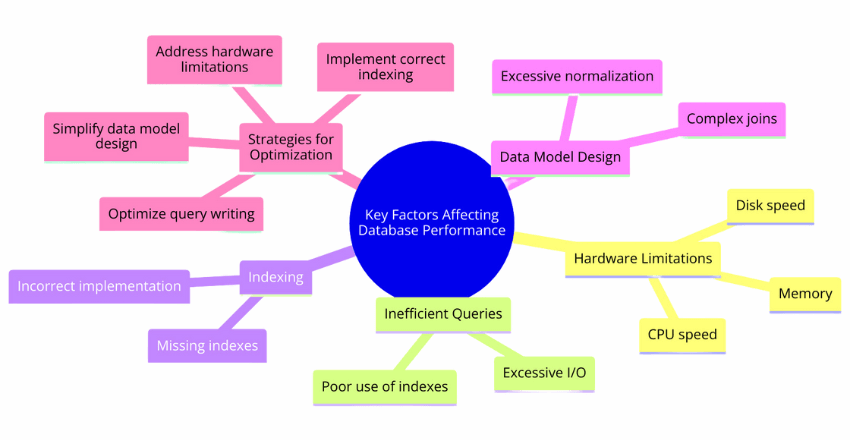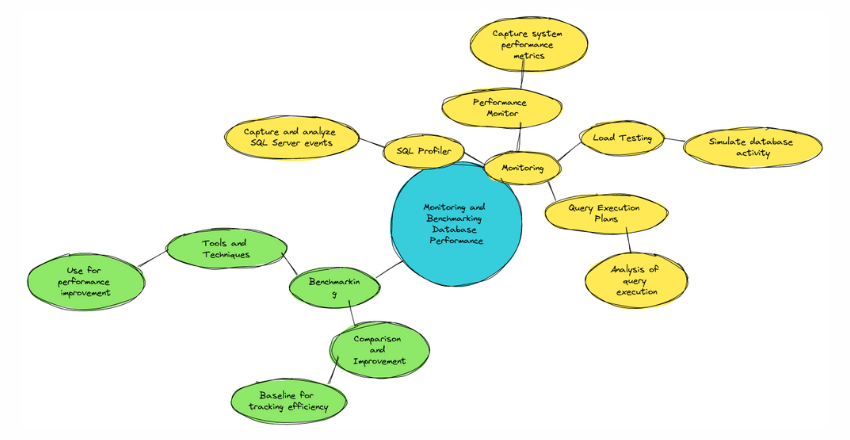 Database performance tuning is the process of optimizing the performance of a database. It involves identifying and addressing performance bottlenecks to increase efficiency and speed. With the exponential increase of data in today’s world, tuning a database for optimal performance has become a crucial part of any organization’s database management system.
Database performance tuning is the process of optimizing the performance of a database. It involves identifying and addressing performance bottlenecks to increase efficiency and speed. With the exponential increase of data in today’s world, tuning a database for optimal performance has become a crucial part of any organization’s database management system.
Database Performance Issues
Databases can experience a range of performance issues that can negatively impact overall efficiency. These issues may include slow response times, high CPU usage, and low throughput. It is important to identify these issues and address them promptly to minimize their impact on database optimization.
One common performance issue is inefficient queries, which can lead to slow response times and increased CPU usage. Additionally, indexing and data model design can have a significant impact on database performance. Poor indexing strategies can lead to long query execution times, while a poorly designed data model can adversely affect database efficiency.
Another issue that can impact database performance is hardware limitations. Insufficient memory or disk space can result in slow database performance and low throughput. In addition, inadequate network bandwidth can cause delays when accessing remote databases.
Overall, identifying and addressing performance issues is crucial for database optimization. By implementing strategies to improve database performance, organizations can improve overall efficiency and reduce the risk of costly downtime.
Key Factors Affecting Database Performance

In order to optimize database efficiency, it is important to understand the various factors that can impact performance. Some of the key factors affecting database performance include:
- Hardware limitations: The hardware on which the database is running can have a significant impact on performance. Factors such as CPU speed, memory, and disk speed can all affect database performance.
- Inefficient queries: Poorly written queries that do not make use of indexes or that require excessive I/O can lead to slow performance.
- Indexing: Incorrectly implemented or missing indexes can also have a significant impact on performance.
- Data model design: A poorly designed data model can lead to performance issues, particularly if it involves complex joins or excessive normalization.
When tuning a database for optimal performance, it is important to consider all of these factors and take steps to address any issues that are identified. In the following sections, we will explore specific techniques and strategies for optimizing database performance and improving database efficiency.
Database Performance Tuning Techniques
Database performance tuning techniques are essential in optimizing database efficiency and ensuring smooth operation of databases. Here are some key techniques for enhancing database performance:
Query Optimization
Query optimization is a crucial step in improving database performance. Optimized queries reduce the time taken to execute them, thus enhancing database efficiency. Here are some tips for optimizing SQL queries:
- Avoid using SELECT * in queries and instead specify only the necessary columns.
- Use WHERE clauses to filter out unnecessary rows.
- Avoid using subqueries unless necessary.
- Minimize the use of ORDER BY and GROUP BY clauses as they can slow down queries.
Example:
SELECT column1, column2 FROM table WHERE column3 = value;Index Optimization
Indexes are database structures that enhance query performance by providing faster access to data. Optimized indexes can significantly improve database performance. Here are some tips for optimizing indexes:
- Choose the right type of index for each table.
- Avoid creating too many indexes as it can adversely affect database performance.
- Ensure that indexes are regularly maintained.
Database Configuration Optimization
Database configuration can significantly impact database performance. Configuration parameters and settings can be optimized to enhance database efficiency. Here are some tips for optimizing database configuration:
- Allocate sufficient memory to the database.
- Optimize disk I/O by using RAID configurations.
- Configure parallelism settings to improve query performance.
Caching Strategies
Caching involves storing frequently accessed data in memory to reduce the number of database queries. Caching strategies can significantly improve database performance. Here are some tips for implementing caching strategies:
- Use data caching to store frequently accessed data.
- Use output caching to cache the results of frequently executed queries.
- Implement query caching to store the results of frequently executed queries.
Implementing these database performance tuning techniques can significantly improve database efficiency and ensure smooth operation of databases.
Monitoring and Benchmarking Database Performance

Monitoring and benchmarking are essential components of database maintenance and optimization. By regularly monitoring database performance, administrators can identify and address issues before they become problematic. Benchmarking allows for comparison and improvement over time, providing a baseline for tracking database efficiency and performance.
There are various tools and techniques available for monitoring and benchmarking database performance. These include:
- SQL Profiler: a tool that can capture and analyze SQL Server events, allowing for investigation of query performance and database activity.
- Performance Monitor: a Windows tool that can capture system performance metrics, including CPU usage, disk I/O, and memory allocation.
- Query Execution Plans: a feature in SQL Server Management Studio that allows for analysis of query execution, including identifying bottlenecks and optimizing query performance.
- Load Testing: a process for simulating database activity and stress testing to evaluate database performance under different conditions.
By using these tools and techniques, administrators can proactively monitor and improve database performance, ensuring optimal efficiency and reliability.
Indexing Best Practices for Improved Performance
Optimizing indexes is an essential step in enhancing database performance. It involves selecting the right index and optimizing existing ones while avoiding common indexing pitfalls. Here are some indexing best practices to improve database performance:
- Choose the correct type of index: The most common index types are clustered, non-clustered, and full-text indexes. Clustered indexes sort and store the data rows in the table based on the index key, while non-clustered indexes use a separate structure to store the index data. Full-text indexes are used for text-based searches. Choose the type of index that best suits your data and query requirements.
- Index only what you need: Indexing everything can hurt database performance. Avoid indexing columns that are frequently updated or have low selectivity. Use the Query Execution Plan to identify missing indexes and index only columns that are part of the WHERE or JOIN clauses.
- Avoid over-indexing: Too many indexes can slow down insert, update and delete operations. Limit the number of indexes per table to those that are essential for query performance.
- Optimize existing indexes: Use the Database Engine Tuning Advisor to identify unused indexes and consider removing them. Identify and remove duplicate indexes that serve the same purpose. Combine multiple indexes that share the same columns into a single covering index.
- Test extensively: Always test index changes in a staging environment before deploying them to production. Use SQL Profiler or Extended Events to monitor the impact of index changes on query performance.
Database Configuration Optimization

Configuring your database system for optimal performance requires understanding the performance tuning parameters and settings. Proper configuration can make a tremendous difference in database performance and efficiency. Here are some tips for database configuration optimization:
- Memory allocation: Allocate enough memory for the database to prevent excessive paging and disk I/O. Ensure other applications running on the same server do not interfere with the database memory allocation.
- Parallelism: Configure parallelism to allow multiple processors to work simultaneously to process a single query, improving the query’s performance.
- Disk I/O: Use high-performance disks and controllers to ensure rapid data access. Partition data to different disks to prevent disk I/O bottlenecks. Monitor disk I/O to identify potential problems.
- Network: Ensure that network bandwidth is sufficient to handle database traffic. Consider separating database servers from web servers to avoid network congestion.
- Log files: Archive log files regularly to prevent excessive growth, which can cause performance degradation.
- Security: Configure security settings to minimize the impact on database performance.
Optimizing database performance involves a series of trade-offs and compromises. What works well for one system may not work for another. That’s why it’s essential to work with a skilled SQL developer to implement optimal database performance tuning parameters.
Performance Tuning Parameters
Here are some essential tuning parameters to consider when optimizing database configuration:
| Parameter | Description |
|---|---|
| max_connections | Maximum number of concurrent connections to the database |
| work_mem | Amount of memory allocated for each sorting and hashing operation |
| shared_buffers | Amount of memory allocated for shared memory buffers |
| effective_cache_size | Amount of memory available for disk caching |
| maintenance_work_mem | Amount of memory allocated for maintenance operations such as index rebuilds |
| checkpoint_completion_target | Time spent on writing checkpoint records during a checkpoint |
Properly setting these parameters depends on the hardware configuration and usage patterns of your database. However, setting them appropriately can significantly improve database performance.
Query Optimization Techniques
Query optimization is a fundamental part of database performance tuning. With inefficient queries, even a well-tuned database can experience significant performance issues. To optimize your SQL queries, consider the following:
- Use indexes effectively: Indexes can make a significant difference in query performance. Consider adding indexes to columns frequently used in joins or where clauses. However, be cautious not to over-index, as this can lead to unnecessary overhead and decreased write performance.
- Eliminate unnecessary joins: Unneeded joins can slow down query performance. Ensure that you only join tables where necessary and that the join criteria are accurate.
- Use subqueries wisely: Subqueries can be useful for complex queries, but they can also be expensive. Consider using derived tables or query rewrites to optimize subqueries where possible.
- Avoid expensive operations: Certain operations, such as sorting and grouping, can be expensive. Limit their use when possible, and consider optimizing queries to use more efficient alternatives where possible.
With these optimizations, the query runs more efficiently, provides the necessary results faster, and minimizes the load on the database system.
Database Maintenance and Data Model Design

Regular database maintenance is critical for ensuring optimal performance. Tasks like index reorganization and statistics updates can significantly improve query performance, while also reducing the risk of data corruption and other errors. It’s important to establish a regular maintenance schedule to keep your databases in top condition.
Additionally, a well-designed data model can have a significant impact on database efficiency. By properly structuring tables and relationships, you can minimize redundant data and improve the readability and maintainability of your code. This, in turn, can improve query performance as well as database scalability and flexibility.
When designing a data model, it’s important to consider factors like normalization, data types, and primary and foreign keys. Normalizing data can help eliminate redundancy and ensure consistency, while choosing appropriate data types can improve efficiency and accuracy. Proper use of primary and foreign keys can also improve query performance and reduce the likelihood of errors.
Overall, investing time and resources into database maintenance and data model design can pay significant dividends in terms of performance and reliability. By implementing best practices in these areas, you can optimize your databases for maximum efficiency and productivity.
If you’re working with SQL databases, you may find it useful to include code examples to illustrate various techniques for maintenance and design.
For example, you might show how to create and modify indexes, or how to use foreign keys to establish relationships between tables. By including these examples, you can help readers better understand the concepts and techniques discussed in the article.
External Resources
https://www.ibm.com/docs/en/product-master/12.0.0?topic=database-maintenance-tasks
FAQ

1. How can you optimize SQL query performance for large datasets?
FAQ Answer:
Optimizing SQL query performance for large datasets often involves refining the query structure, utilizing proper indexing, and leveraging the database’s execution plans to identify bottlenecks. A common approach is to minimize the amount of data processed by the query through selective filtering and to use indexes effectively to speed up data retrieval.
Code Sample:
-- Example of a poorly performing query
SELECT * FROM sales
JOIN customers ON sales.customer_id = customers.id
WHERE customers.country = 'USA';
-- Optimized query with an index-friendly condition
SELECT sales.* FROM sales
JOIN customers ON sales.customer_id = customers.id
WHERE customers.country = 'USA'
AND sales.date BETWEEN '2023-01-01' AND '2023-12-31';Explanation: The optimized query includes a date range filter on the sales.date column, which, assuming an index on this column, significantly reduces the number of rows to be examined. This kind of selective filtering, especially when combined with indexing, can drastically improve performance on large datasets.
2. What strategies can be used to reduce locking and improve concurrency in databases?
FAQ Answer:
Reducing locking and improving concurrency in databases can be achieved by implementing optimistic concurrency control, using appropriate transaction isolation levels, and optimizing transaction scopes to be as short as possible. This minimizes the time locks are held and reduces the chance of conflicts between concurrent transactions.
Code Sample:
-- Using SQL Server's snapshot isolation to reduce locking
BEGIN TRANSACTION;
SET TRANSACTION ISOLATION LEVEL SNAPSHOT;
SELECT * FROM orders WHERE order_id = 123;
-- Perform updates or other operations
COMMIT TRANSACTION;Explanation: This code snippet demonstrates the use of the snapshot isolation level in SQL Server, which allows a transaction to work with a consistent snapshot of the database. This approach prevents it from being blocked by other transactions, thus improving concurrency by reducing locking conflicts.
3. How do you determine and create effective indexes for a database?
FAQ Answer:
Determining and creating effective indexes involves analyzing query patterns to identify frequently accessed columns and understanding the types of queries (e.g., range queries, exact match queries) that are common for your application. The use of the database’s query plan analysis tools can help identify which columns would benefit most from indexing.
Code Sample:
-- Analyzing a query to identify potential indexes
EXPLAIN SELECT * FROM users WHERE last_name = 'Smith';
-- Creating an index based on the analysis
CREATE INDEX idx_users_last_name ON users(last_name);Explanation: The EXPLAIN statement (syntax varies by RDBMS) analyzes how the database executes a query, helping to identify potential bottlenecks, such as full table scans that could be optimized with an index. Based on the analysis, an index is created on the last_name column of the users table to speed up searches by last_name.
James is a highly acclaimed author renowned for his extensive experience in the realm of data development and architecture, offering valuable insights to the data industry through his compelling literary works. Residing in the charming city of Oxford, he embarked on an illustrious academic journey at Oxford University, where he delved into the intricate world of computer science. This foundation served as the catalyst for his exceptional career.
After completing his studies, James embarked on a professional path that led him to renowned technology giants. He first honed his skills as a data developer at Microsoft, where he showcased his prowess in designing and implementing robust data solutions. His innovative contributions played a pivotal role in enhancing data management processes, solidifying his reputation as a meticulous and forward-thinking professional.
Seeking new challenges and broader horizons, James embarked on a transformative journey at Amazon Web Services (AWS). In this influential position, he leveraged his profound understanding of data architecture to shape cutting-edge solutions for clients. His leadership and technical acumen enabled businesses to harness the power of cloud computing and revolutionize their data management practices, further solidifying his status as an industry authority.







